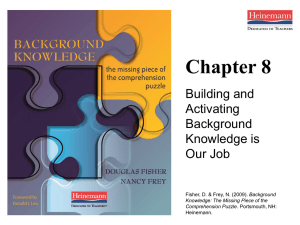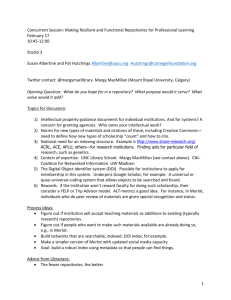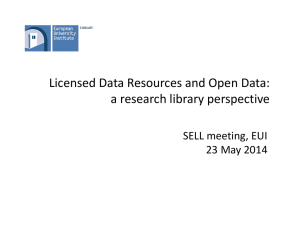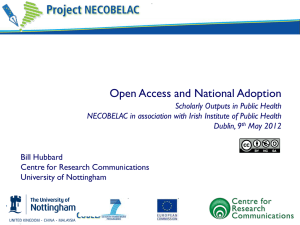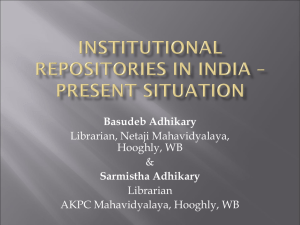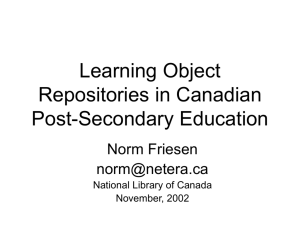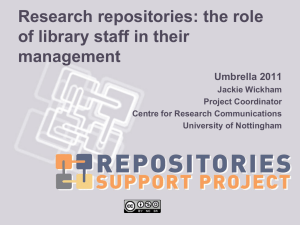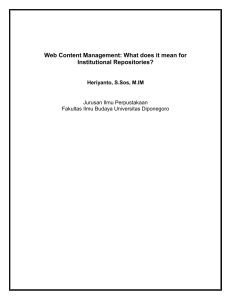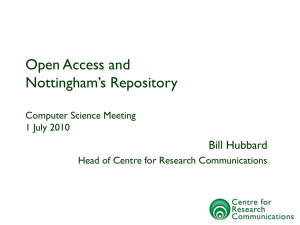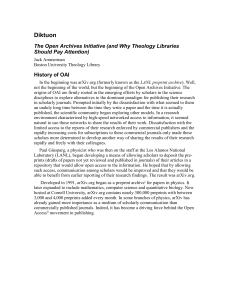10. Building Learning Objects
advertisement
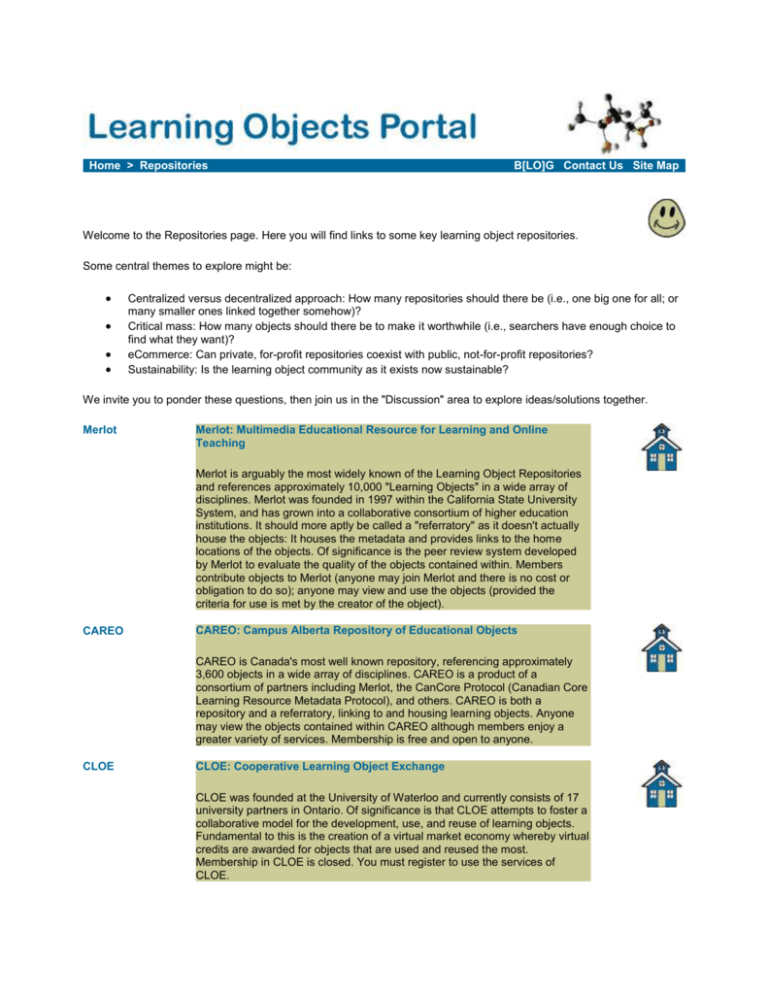
Home > Repositories B[LO]G Contact Us Site Map Welcome to the Repositories page. Here you will find links to some key learning object repositories. Some central themes to explore might be: Centralized versus decentralized approach: How many repositories should there be (i.e., one big one for all; or many smaller ones linked together somehow)? Critical mass: How many objects should there be to make it worthwhile (i.e., searchers have enough choice to find what they want)? eCommerce: Can private, for-profit repositories coexist with public, not-for-profit repositories? Sustainability: Is the learning object community as it exists now sustainable? We invite you to ponder these questions, then join us in the "Discussion" area to explore ideas/solutions together. Merlot Merlot: Multimedia Educational Resource for Learning and Online Teaching Merlot is arguably the most widely known of the Learning Object Repositories and references approximately 10,000 "Learning Objects" in a wide array of disciplines. Merlot was founded in 1997 within the California State University System, and has grown into a collaborative consortium of higher education institutions. It should more aptly be called a "referratory" as it doesn't actually house the objects: It houses the metadata and provides links to the home locations of the objects. Of significance is the peer review system developed by Merlot to evaluate the quality of the objects contained within. Members contribute objects to Merlot (anyone may join Merlot and there is no cost or obligation to do so); anyone may view and use the objects (provided the criteria for use is met by the creator of the object). CAREO CAREO: Campus Alberta Repository of Educational Objects CAREO is Canada's most well known repository, referencing approximately 3,600 objects in a wide array of disciplines. CAREO is a product of a consortium of partners including Merlot, the CanCore Protocol (Canadian Core Learning Resource Metadata Protocol), and others. CAREO is both a repository and a referratory, linking to and housing learning objects. Anyone may view the objects contained within CAREO although members enjoy a greater variety of services. Membership is free and open to anyone. CLOE CLOE: Cooperative Learning Object Exchange CLOE was founded at the University of Waterloo and currently consists of 17 university partners in Ontario. Of significance is that CLOE attempts to foster a collaborative model for the development, use, and reuse of learning objects. Fundamental to this is the creation of a virtual market economy whereby virtual credits are awarded for objects that are used and reused the most. Membership in CLOE is closed. You must register to use the services of CLOE. Others The Academic ADL Co-Lab in Wisconsin has complied a list of active repositories. The Centre for International Education at the University of Wisconsin has compiled a list of general, discipline specific, and commercial repositories. The goal of EduSource is to create an infrastructure (tools, systems, protocols, practice) to link repositories across Canada. The government of Canada funds EduSource federally The University of Texas at San Antonio has compiled a list of learning object repositories complete with quick reference information; for example: the educational level each repository is geared towards, founding organization, country of origin, current status, and access policy. © 2003 MDDE663: Learning Objects Group Home > Tools B[LO]G Contact Us Site Map Welcome to the Tools page. This page summarizes some of the tools that can be used to evaluate, create and modify learning objects. LCMS Learning Content Management Systems explained. Learning Object Evaluation Criteria Merlot has a set of criteria it uses to evaluate the learning objects it places in its repository. Kathleen Bennett and Susan E. Metros adapted Merlot's criteria into a checklist. Metadata Tool ALOHA is an example of a metadata tool for learning objects. It is available through the Learning Commons site at the University of Calgary and has been designed to accommodate any type of metadata markup. CETIS List of Tools Comprehensive list of tools on the Centre for Educational Technology Interoperability Standards (CETIS). Home > Best Practices B[LO]G Contact Us Site Map Welcome to the Best Practices page. From Letterman to Learning Objects, this page provides some of the Best Practices for Learning Objects in the style of a "Top 10" list. 10. Building Learning Objects > Learning Objects Pioneers, Barron T. (2000), Learning Circuits - ASTD's Online Magazine All About E-Learning This article describes three organizations that have developed systems and structures for the development and use of learning objects. Cisco developed RIO's (Reusable Information Object — an individual component of a learning objective) and RLO's (Reusable Learning Object — the sum of RIO's needed to fill those objectives derived from a specific job task. Honeywell used Netg to develop, store and reuse NLO's (Netg Learning Objects). If any Honeywell engineer needs a piece of information, he/she can navigate the learning repository and obtain the relevant NLO. American Express is using Mindlever's Kaleidoscope to build a Web-based corporate learning centre. Two issues were identified in this article: 1. 2. 9. Applications of Learning Objects Virginia Community College System describes three examples of how one learning object is used in three separate educational contexts. The examples demonstrate that a learning object must consist of data relevant 8. Evaluation of Learning Objects Methods of defining objects: the size of chunks of information, and interoperability across systems from different vendors will become key issues. How vendors will allow customers to use their learning objects: Buy or rent or pay-as-you-use is a relevant issue. to the purpose and context of the activity the pedagogy in the information, and the assignments associated with the learning objects. Learning objects in distance education: Addressing issues of quality, learner control and accessibility (Gretchen Lowerison, Genevieve Gallant and Prof. Gary Boyd) This paper examines the potential benefits of learning objects with emphasis on issues that facilitate high quality teaching and learning. A checklist is presented to guide in the selection of learning objects. 7. Macromedia's Learning Object Development Center Developing Learning A set of white papers and sample applications around the development of Objects learning objects using Macromedia's suite of products. 6. Great Idea, but how do I do it? A practical example of learning object Structured Content creation using SGML/XML (Janet Bartz) Development Model This paper offers a "how-to" of learning object implementation, for text, based on the author's four years experience working with Open Learning Agency’s structured content development model. > 5. Metadata IMS Learning Resource Meta-data Best Practices and Implementation Guide The IMS Meta-data Best Practice and Implementation Guide provides general guidance about how an application may use the Core and Extended meta-data elements. 4. Learning Design IMS Learning Design Best Practice and Implementation Guide These best practices provide a generic and flexible language designed to enable many different pedagogies to be expressed. The language was originally developed at the Open University of the Netherlands (OUNL). It is supported by a Learning Design Forum. 3. Faculty Development Preparing Teachers To Use Learning Objects by Tuiren A. Bratina, Darrin Hayes and Steven L. Blumsack (2002), The Technology Source (ISSN 15320030) An article in the peer-reviewed bimonthly periodical published by the Michigan Virtual University that provides some strategies intended for post-secondary educators. 2. K-12 Development Expert Practice and the Development of Learning Objects: Essential Resources for Online and Distributed Education Increasingly teachers who work in K-12 online learning environments or in distributed learning centers are curriculum generalists. These generalists are typically hired for their skills in social interaction, online facilitation, or counseling rather than a specific subject area specialization. As these generalists work with their students, gaps tend to appear between the knowledge of both the students and teachers and their understanding of key concepts within academic curriculum. This presentation from Best Practices in e-Learning Web site at the University of Calgary proposes an intervention strategy built on the theory of expert practice and the development of learning objects. 1. Community of Practice Learning Objects Virtual Community of Practice The National Learning Infrastructure Initiative (NLII) has designed and implemented four Virtual Communities of Practice pilots (October 2002 through December 2003), including the Learning Objects Virtual Community of Practice. The NLII Learning Objects Virtual Community of Practice strives to create a collaborative environment that supports and extends investigation by the greater academic and business community into issues about and attributes of learning objects and the broader management of knowledge. Application and policy issues, as well as evolving definitional issues of this topic, are examples of discussion areas. This community has defined an initial community purpose to investigate the status of learning object theory and practice. © 2003 MDDE663: Learning Objects Group

